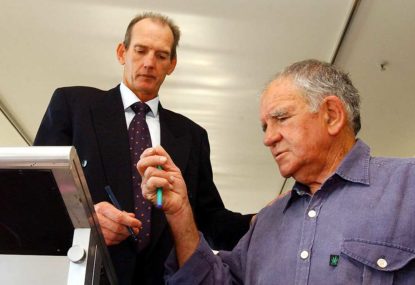WATCH: 'You look like a marriage celebrant!' Gus 'rips JT apart' out of the blue over his scarf
Gus Gould went from analysing Daly Cherry-Evans' fantastic pass to roasting Johnathan Thurston in a heartbeat, leaving his Nine colleagues in hysterics.

There have been any number of people who have changed the rate of progression in rugby league. Of the two I’ve had the opportunity to witness closely, one is known in footy circles worldwide, while the other is known by few.
The first was Jack Gibson, who was a great innovator, bringing many American sport-based philosophies and routines to our sport.
More than that, he dared to be the boss at a time when football clubs were run by committees of men. Bear in mind Jack said committees are cul-de-sacs where good ideas go missing!
Through this sort of dominant leadership the whole face of the game changed – rapidly. Along with his great mate and great footy mind Ron Massey, Gibson revolutionised those clubs he touched and ultimately the whole sport.
>>>Read more from Brian Smith on Smithy Speaks.
The other man was just so different. A mild mannered, softly spoken, supreme mind on all things footy. Max Ninness is not a name many of you will know, but the man is without doubt the greatest fountain of knowledge I have met.
Ask anyone from 1991 until Wayne Bennett’s entry to the Dragons den almost two decades later. Coaches Smith, David Waite, Andrew Farrar and Nathan Brown were heavily influenced by ‘Maxo’.
His depth of knowledge in skill development and tactical team play was unique and game leading. It was at the core of four grand final appearances at a time when St George and eventually the merged entity with Illawarra Steelers were not nearly flush with funds. Shoe string might not be the right phrase, but it was a pretty tight budget in my time and beyond I believe.
Getting the most out of players was how Maxo could assist and guide young coaches – and all players who cared to listen. Just like supercoach Gibson’s incredible influence, so too did the powerful footy insights Ninness gave build confidence in individuals and our teams.
These became great problem-solving techniques to assist dedicated but sometimes limited players and teams reach heights I for one feel honoured to have experienced.
Ask players and coaches at all levels of that great club and they will smile when the name Max Ninness is mentioned. I can see some of that influence in Paul McGregor and his team’s style right now.
In today’s world of footy, the influence of science and technology dominates. ‘The team with the most toys wins’ seems the best descriptor. Certainly the clubs who utilise the detailed scientific explanation and feedback provided are consistently near the top.
So don’t be fooled by the stuff you hear from some of our best coaches – or rather don’t hear. They are somewhere between secretive and paranoid in not acknowledging the degree of influence they gain from the latest in technology and science.
Other sports were way ahead of the old days of footy but coaches like Des Hasler have long since thrown off the ‘doing what we have always done’ syndrome.
And it’s no exaggeration to say it’s changing from one week to the next. From wellness measurements of health and vitality to GPS data that looks like a report on a rocket ship, the detailed measurements through analysis have moved massively in the past decade.
Forecasting injury prevention with sports medicine experts and all the info from that world is also a huge innovation, as is the equipment in physio rooms in those clubs that can afford them.
These are all tremendous advantages and potential upgrades in management techniques to maximise players’ performance on game day.
Video analysis and software packages enable the smartest coaches and analysts to break down the who, when, where, why and how of both training and playing performances.
‘Stats can be misleading,’ as those who refuse to move on and up the coaching performance tree will shout. What they don’t tell you is they can also be incredibly helpful in enlightening both player and coach as to how to improve performance. The coaches of tomorrow are all over this stuff.
Keegan Smith, unashamedly biased as I am on this matter, is at the cutting edge of sports performance, based on a sensible and seemingly obvious logic. His point of difference to many others is ‘If an athlete’s life, general health and fitness are at a less than optimal level, how can highly paid experts in clubs expect their players to achieve optimal performance?’
Together with a different take on footy-specific preparation, physically and mentally, he has seen a tremendous take-up of his methods in the past few years.
His influence on the Roosters premiership-winning crew in 2013 is strong evidence of what a difference his methods have made to those who adopt his mantra of discipline in lifestyle.
There are many other people and innovations making a huge impact on your club right now. Often you don’t hear about it because the club don’t want to give up a competitive edge, but sometimes it’s because they don’t have it because they can’t afford it. There are massive differences in club budgets in this area.
There are also some dinosaurs when it comes to administrators and coaches. You would be surprised at the methods some still employ. There have been cases in pro sports across the world where professional negligence in player welfare has been contested in courts.
Why would a professional player want to be part of a regime highly likely to shorten their career courtesy of archaic flogging the athlete to professional death?
If it’s not a factor now for some, it will be soon for all.